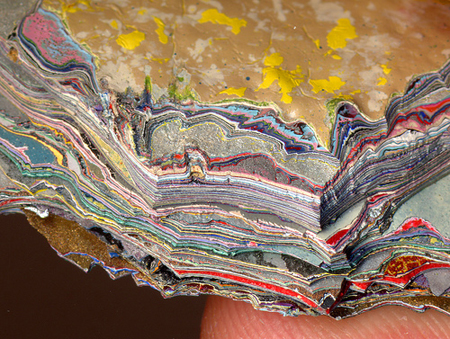"One could read the battle of the walls much the way an archaeologist reads stratigraphy - layer by layer - each layer of paint indicating a partial and temporary victory in an ongoing battle." This made me think. At first I thought of onions, because they too have layers. But onions are peeled towards the center and aren't oriented from top-to-bottom. Stratigraphy really is great comparison. the past is hidden. Time erodes and time conceals. It rots and it hides. So too, it seems, does this graffiti. Yet (as the picture below shows), all that remains with graffiti is an outline of the past. A color scheme of conflict. It is as if an archaeologist dug beneath the present only to find scorched earth, an ashen past. Nonetheless, strata and graffiti pile up in a dialogue of time and space, regardless whether it's heard or not.
How is it that a layer of paint can more successfully conceal than a period of a thousand years? Does the one with the darkest paint and the quickest hand win the battle of time?
The picture below is one of my favorite works. On the surface, and at first glance, you notice the word "delete." There is no doubt that this artist wants this wall gone. But more important and profound, in my opinion, is what the keyboard command really means. CTRL-ALT-DLT on a windows computer opens the "task manager." You perform this command when a program is "not responding." Then, you are either able to troubleshoot the program or just "force quit" the program. Either way, it puts you in control, or it gives you a better chance of solving the problem than just clicking 317 times. It opens a "dialogue"window where you can see all of the programs contributing to your computer usage, which paints and picture of actors that were seemingly invisible. It might be a stretch, but the metaphor could work. It's likely, however, that the artist did not intend to evoke this image. The command has in the past been used to just denote deletion or disappearance. In that case, it could be CTRL-A-DLT.


Wow! Really amazing, Jacob! Very clever...and makes so much sense...layers of earth that hide away the sweet and the evils of time. That concept can surely be applied to so much, even the graffiti on the wall....paint, opinions, contemplation, wind, rain, erosion of paint, memories...paint.....
ReplyDeleteI really enjoyed your analysis of the photograph. My first thought was that the painter was simply implying the removal of the wall, but your deeper analysis really struck me. I think it definitely suggests a need to "troubleshoot" the underlying problem in an attempt to get to the root of the issue at hand.
ReplyDeleteThis is super interesting, and something I haven't thought of before. I really like how you described it as "a color scheme of conflict." I love the idea of thinking of graffiti as a conversation, and the fact that as you pointed out, that graffiti doesn't disappear necessarily; a lot of times it's just covered up by a new dialogue.
ReplyDeleteI really liked how you compared the graffiti on the way to an archeologist site with all the layers underneath. I also think your analysis of the control alt delete was really insightful and it made a lot of sense. I like how you used the graffiti as a metaphor for taking control.
ReplyDelete